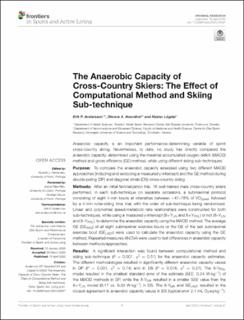| dc.description.abstract | Anaerobic capacity is an important performance-determining variable of sprint cross-country skiing. Nevertheless, to date, no study has directly compared the anaerobic capacity, determined using the maximal accumulated oxygen deficit (MAOD) method and gross efficiency (GE) method, while using different skiing sub-techniques. Purpose: To compare the anaerobic capacity assessed using two different MAOD approaches (including and excluding a measured y-intercept) and the GE method during double poling (DP) and diagonal stride (DS) cross-country skiing. Methods: After an initial familiarization trial, 16 well-trained male cross-country skiers performed, in each sub-technique on separate occasions, a submaximal protocol consisting of eight 4-min bouts at intensities between ~47–78% of V.O2peak followed by a 4-min roller-skiing time trial, with the order of sub-technique being randomized. Linear and polynomial speed-metabolic rate relationships were constructed for both sub-techniques, while using a measured y-intercept (8+YLIN and 8+YPOL) or not (8–YLIN and 8–YPOL), to determine the anaerobic capacity using the MAOD method. The average GE (GEAVG) of all eight submaximal exercise bouts or the GE of the last submaximal exercise bout (GELAST) were used to calculate the anaerobic capacity using the GE method. Repeated measures ANOVA were used to test differences in anaerobic capacity between methods/approaches. Results: A significant interaction was found between computational method and skiing sub-technique (P < 0.001, η2 = 0.51) for the anaerobic capacity estimates. The different methodologies resulted in significantly different anaerobic capacity values in DP (P < 0.001, η2 = 0.74) and in DS (P = 0.016, η2 = 0.27). The 8-YPOL model resulted in the smallest standard error of the estimate (SEE, 0.24 W·kg−1) of the MAOD methods in DP, while the 8-YLIN resulted in a smaller SEE value than the 8+YLIN model (0.17 vs. 0.33 W·kg−1) in DS. The 8-YLIN and GELAST resulted in the closest agreement in anaerobic capacity values in DS (typical error 2.1 mL O2eq·kg−1). Conclusions: It is discouraged to use the same method to estimate the anaerobic capacity in DP and DS sub-techniques. In DP, a polynomial MAOD method (8-YPOL) seems to be the preferred method, whereas the 8-YLIN, GEAVG, and GELAST can all be used for DS, but not interchangeable, with GELAST being the least time-consuming method. | en_US |

